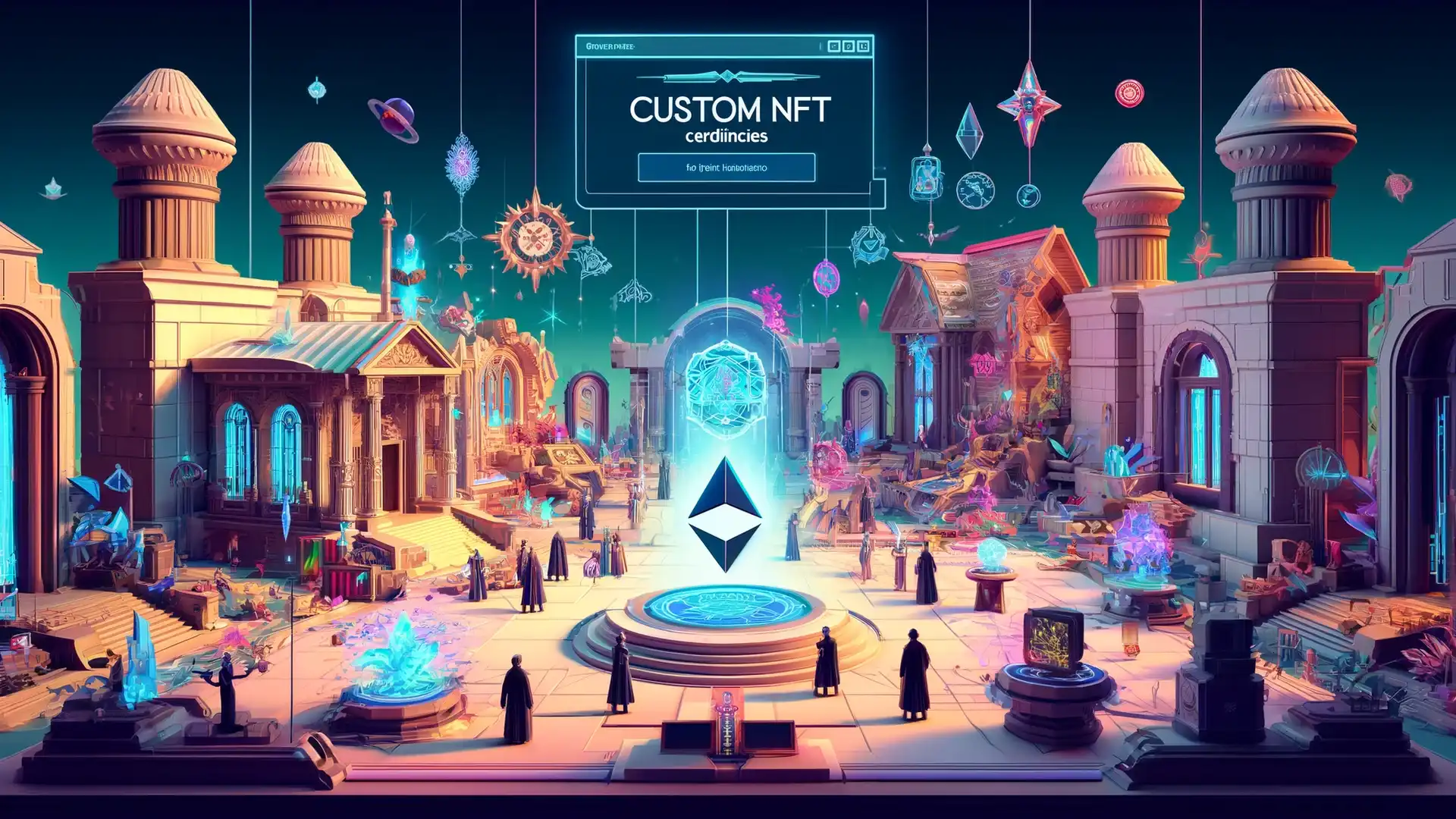Customizing and Personalizing Educational NFT Credentials

 Author:
Artem Grigoriev
Author:
Artem Grigoriev
Crafting Personalized Learning Experiences: Innovations in NFT Credentials
The potential for NFTs (Non-Fungible Tokens) within the educational sector extends well beyond simply digitizing certificates. Instead, these blockchain-based assets transform certificates into something revolutionary. They uniquely and securely represent academic achievements, adding a personalized touch . This chapter explores the profound impacts of customization and personalization through NFT credentials. These credentials are redefining how academic accomplishments are recognized and engaged with. Educational experts believe that this innovation could dramatically shift the educational paradigm, impacting learner recognition and personal achievement tracking, ultimately enhancing the effectiveness of the educational system.
📘 This article complements: "The Complete Guide to NFT Credentials". Explore it to find answers to all your questions;)
At the core of educational NFTs is the ability to embed rich media, such as videos, images, and links to detailed coursework, directly within the digital credentials. This feature transforms traditional certificates from static documents into dynamic, informative records that can significantly enhance learner engagement . The flexibility inherent in blockchain's smart contracts—self-executing contracts with terms directly written into code—allows credentials to be not only personalized but also capable of evolving. As students achieve new milestones, their digital credentials automatically update to reflect these achievements, creating a continuously adapting record that supports a lifelong learning framework. Researchers at Stanford University suggest that this capability may lead to higher retention rates and encourage deeper learning, as students see real-time growth and achievements.
Personalization in educational NFTs caters to various academic levels and learning styles. By integrating adaptive learning technologies, NFT credentials can adjust content difficulty and modify teaching methods based on real-time performance data from students. This adaptive approach ensures that learning experiences are tailored to meet the unique needs and capabilities of each student, fostering a more effective and individualized educational journey. According to a study by the University of Illinois, such personalized learning environments have led to significant improvements, notably in STEM fields, highlighting the importance of a customizable education system that dynamically responds to the needs of its students.
Furthermore, the personalization of NFT credentials can significantly boost student motivation. These visually appealing and interactive records serve as proof of accomplishment and act as a continuous incentive for students. By making academic achievements tangible and dynamic, NFTs can increase intrinsic motivation, encouraging students to engage more deeply with their studies and pursue further learning opportunities. This transformation is supported by psychological studies that show visual and interactive learning tools can drastically enhance motivation and engagement among learners. The engagement provided by these tools plays a crucial role in the modern educational landscape, where capturing and maintaining student interest is a predominant challenge.
💡 Note: The integration of rich media and adaptive learning within NFTs offers a multifaceted approach that places the student at the center of their academic journey, promoting a deeper and more engaging learning experience. Leveraging NFT technology in this manner not only enhances educational outcomes but also equips students with the skills necessary for navigating an increasingly digital world.

Despite the extensive customization options, the security of educational credentials remains paramount. Advanced cryptographic methods are employed to secure each NFT, ensuring that the integrity and verifiability of the credentials are never compromised. This security aspect reassures both educational institutions and students that the digital records are both authentic and resistant to tampering. The implementation of such security measures aligns with global best practices for digital data protection, ensuring that educational NFTs comply with stringent international security standards. Maintaining this level of security is essential to preserve the trust and credibility of educational credentials in a digital age.
This chapter also explores the real-world applications of personalized educational NFTs, highlighting several current implementations and pilot programs that have successfully utilized these digital assets. These examples not only demonstrate the practical applications of NFTs in education but also offer valuable lessons on how personalization can profoundly impact student engagement and motivation. For instance, the University of Blockchain and Ledger Technologies has reported significant success in using NFTs to map out individual learning pathways, leading to increased student satisfaction and academic achievement. These successes showcase the tangible benefits that such technologies can bring to the educational sector.
As educational paradigms shift towards more customized and interactive methods, personalized NFT credentials stand out as a powerful tool. They make learning more relevant and responsive to individual career paths and life goals. By exploring these innovations, we can better understand the capabilities and future potential of NFTs in transforming educational experiences into something far more personal and impactful. This understanding is critical as we consider the future directions of educational technology and its role in crafting comprehensive, engaging, and secure educational experiences.
💡 Tip: For educators and institutions considering the adoption of NFT credentials, focusing on scalability and security is crucial. Ensure the blockchain infrastructure used can support a highly personalized yet secure learning environment. This foresight will be key in fostering a technologically advanced yet intrinsically safe educational landscape. Embracing this technology can provide a significant competitive advantage in the rapidly evolving educational sector.

Transforming Education with Customized NFT Solutions: Case Studies and Future Directions
The potential of Non-Fungible Tokens (NFTs) to revolutionize the educational landscape is becoming increasingly clear. Institutions are exploring their ability to provide personalized and secure credentials . This chapter dives into detailed case studies. They show how educational institutions like MIT and Stanford have successfully implemented NFT solutions, illustrating their transformative impact. These institutions use NFTs to certify and track a range of educational outcomes. They highlight a significant shift toward more technologically integrated educational practices. These practices leverage the security and flexibility of blockchain technologies. Blockchain technologies are decentralized digital ledgers that securely record transactions.
Starting with a detailed examination, this section outlines the processes involved in conceptualizing, developing, and deploying personalized NFT credentials. Key stages include:
- Defining personalization parameters that align with educational goals.
- Developing NFTs on secure blockchain platforms.
- Launching innovative solutions.
Real-world examples from pioneering institutions like the University of Nicosia are highlighted. This institution has effectively used blockchain to issue digital diplomas— reducing fraud and improving administrative efficiency . These examples serve as a blueprint for others, powerfully illustrating how blockchain can enhance credentialing processes and administrative operations within educational settings.
One major challenge in personalizing NFT credentials is ensuring they can scale up, especially as student numbers grow. This chapter explores how blockchain technologies are optimized to handle large-scale implementations. Strategies such as sharding (which divides the database to spread the load) and layer-two solutions (additional processing layers that handle transactions off the main blockchain) are discussed. These technologies are essential for accommodating the increased workload while maintaining the performance and security of the system. They ensure that educational institutions can maintain high standards as they expand their use of blockchain technologies.
💡 Note: Layered security protocols, including multi-factor authentication and end-to-end encryption, are critical for safeguarding sensitive student information. They ensure that NFT credentials remain tamper-proof and private. These security measures are foundational in maintaining the trust and confidence of all stakeholders in the digital credentialing ecosystem.

Future trends in educational NFTs point toward a more dynamic integration of technology. For instance, the potential use of artificial intelligence (AI) to update NFT credentials in real-time is promising. This automates the verification process and ensures that student credentials are continually updated. The system becomes highly responsive and personalized. The integration of AI enhances the adaptability and responsiveness of NFT-based credentialing systems. It tailors them to the needs and developments of individual students.
Additionally, decentralized storage solutions are being considered to enhance data security and accessibility. Such technologies could decentralize the storage of credential data across multiple nodes, making it more resistant to hacks and data loss. They ensure that information remains accessible and transparent to authorized users. This approach is advantageous in safeguarding against the central points of failure that compromise traditional educational record systems. It enhances the security of data and contributes to a more robust educational infrastructure.
Regulatory considerations are also paramount as the adoption of educational NFTs intersects with global data privacy laws and educational standards. This chapter examines the evolving regulatory landscape, emphasizing the importance of compliance. Navigating this complex regulatory environment is crucial to ensuring that innovations are both legally sound and widely accepted. They help ensure that educational innovations provide benefits without introducing new risks to privacy or security.
Looking ahead, the scalability of personalized educational NFTs is a critical focus. Technological advancements need to be balanced with administrative measures. They ensure that educational institutions can adopt these innovations smoothly without compromising the quality of education or operational efficiency. It is anticipated that as more institutions recognize the benefits, the adoption rate of NFT credentials will accelerate. This prompts further innovations and improvements in the sector. This growing recognition highlights the expanding role of digital solutions in enhancing the educational landscape.
This comprehensive exploration of customized NFT solutions in education showcases successful implementations. It forecasts how these digital tools could continue to evolve, offering students more personalized, secure, and engaging learning experiences. As the digital credentials landscape matures, NFTs stand poised to fundamentally transform educational systems worldwide. The ongoing evolution of these technologies promises to enhance the accessibility, customization, and effectiveness of educational processes. They make learning experiences more tailored and impactful for students around the globe.
💡 Tip: For institutions considering the adoption of NFT-based credentials, it is crucial to start small with pilot programs. These programs can provide valuable insights and data to guide full-scale implementation. They ensure that each step aligns with both educational objectives and technological capabilities. As evidenced by the increasing number of pilot programs worldwide, this phased approach helps mitigate risks. It ensures optimal integration of NFTs into educational systems. This strategic implementation not only tests the viability of digital solutions but also sets the stage for broader adoption and refinement of educational technologies.

Challenges and Limitations of NFT Credentials in Education
Why Not All Educational Institutions Have Adopted NFT Credentials Yet
NFT Credentials Accessibility: Making Education Open to All
NFT Credentials and Lifelong Learning: Best Practices
Applying NFTs in Professional Training, Certification, and Accreditation
